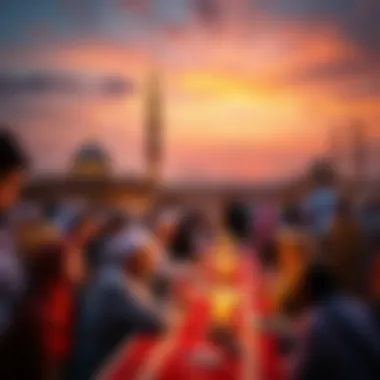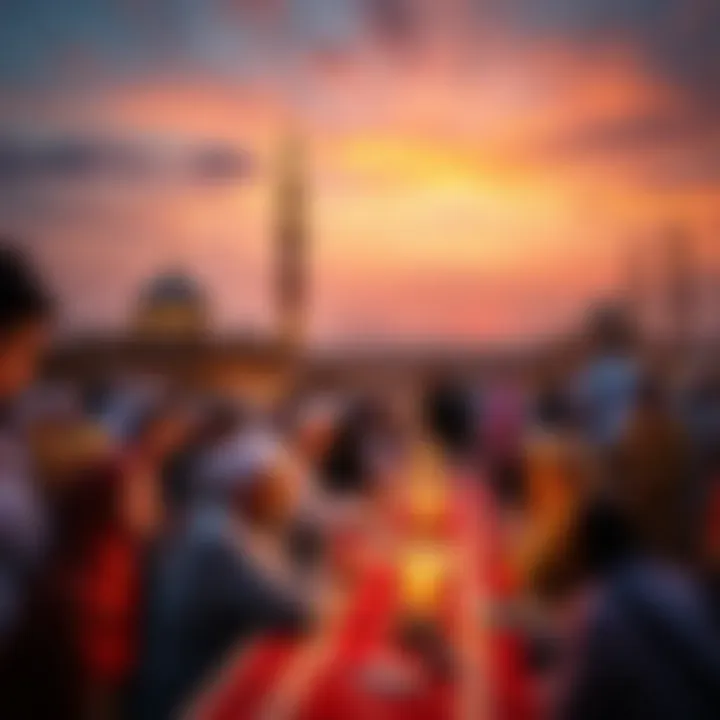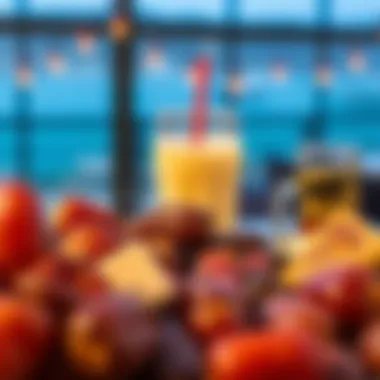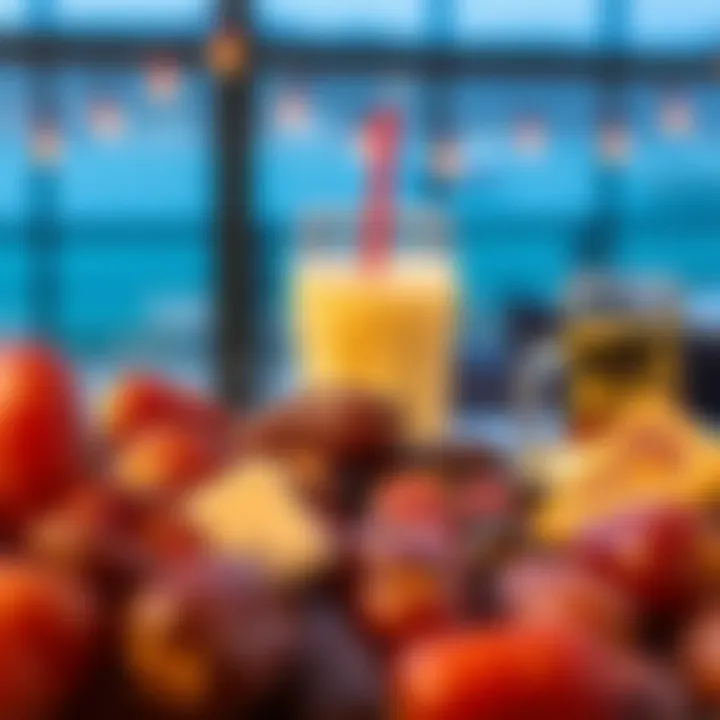Understanding Iftari Time: The Art of Breaking Fast


Intro
Iftari time marks a significant moment each day during Ramadan, the holy month of fasting for Muslims worldwide. It is when families and friends come together to break their fast, sharing food and blessings. This moment is steeped in tradition and cultural significance, as it fosters community bonds and strengthens ties among loved ones.
Breaking the fast isn’t just about eating; it’s a time of reflection and gratitude. The act of fasting throughout the day is deeply spiritual, reinforcing self-discipline and reminding practitioners of the less fortunate. As the sun sets, there’s an almost palpable energy in the air—a mixture of anticipation and joy—as everyone prepares for the evening meal.
During this period, various customs and rituals unfold across different cultures. Some may rush to enjoy dates and water, the Prophet Muhammad's favored way to break the fast, while others might prefer a lavish assortment of regional dishes. The variety of foods consumed during Iftari varies greatly, painting a vibrant picture of culinary diversity.
This article will navigate through the many intricacies of Iftari time. Treat it as your roadmap to understanding not just the rituals but also the cultural undercurrents that influence how communities observe this sacred practice. From the soulful gatherings to the captivating dishes shared, every aspect brings forth a deeper appreciation of why Iftari time matters.
In the following sections, we will explore the historical background, the rituals associated with breaking the fast, the regional favorites on the table, and how the community dynamics evolve around this important time. Let’s embark on this journey to deepen our understanding of Iftari time, revealing the heart and soul of this cherished tradition.
Prologue to Iftari Time
Understanding the significance of Iftari time is pivotal to grasping the essence of Ramadan, a month revered deeply by millions. Iftari, the moment when the fast is broken, is not just a culinary custom; it’s a moment steeped in tradition, spirituality, and community bonding.
As the sun sets, families and friends gather, creating a warm tapestry of togetherness that transcends religious boundaries. It’s a time when the fatigue of fasting gives way to gratitude, fellowship, and, of course, the enjoyment of food. The rituals surrounding Iftari emphasize not only the act of breaking the fast but also the importance of sharing and giving.
In examining the various facets of Iftari, one can appreciate the careful timing that plays a crucial role. From the moment the adhan (call to prayer) resonates, signaling the end of the day’s fast, the atmosphere transforms into one of anticipation and joy.
In this article, we will delve into the rich history underpinning Iftari, its evolving traditions, and the diverse foods featured at the table across different cultures. Understanding Iftari time allows us to recognize its impact on community dynamics, including how it fosters charity and social networks during Ramadan.
Iftar is more than just a meal; it is a celebration of faith, community, and sustenance.
Furthermore, we will explore the variety of culinary delights that grace Iftari tables worldwide, reflecting regional preferences and nutritional implications. By diving into these aspects, we aim to provide a comprehensive overview that underscores why Iftari time holds such a cherished place in the hearts of many.
Cultural Significance of Iftar
Exploring the cultural significance of Iftar reveals a rich tapestry of customs and meanings that stretch far beyond mere sustenance. At its core, Iftar represents a profound shared experience among Muslims worldwide, emphasizing both collective identity and personal reflection during the sacred month of Ramadan. Understanding its significance requires delving into its spiritual and social dimensions, which meld into a unique cultural phenomenon.
Religious Importance
Iftar is not simply an act of eating at sunset; it encapsulates a deep spiritual journey. Throughout Ramadan, fasting from dawn to dusk is seen as a way to purify the soul, grow closer to Allah, and cultivate empathy for those less fortunate. The act of breaking the fast is marked with heartfelt prayers, often beginning with the phrase "Allahumma inni laka sumtu wa bika aamantu wa 'alayka tawakkaltu wa 'ala rizq-ika-aftartu" which translates to "O Allah, I fasted for You, and I believe in You, and I put my trust in You, and with Your sustenance, I break my fast." This invocation underlines the intimate relationship between the act of fasting and faith, as it reminds participants of their reliance on God for sustenance.
Moreover, specific timings related to Iftar have their own religious significance, with the fast traditionally ending at sunset, just as it had begun with the pre-dawn Suhoor. This rhythm of daily life reinforces the importance of discipline, patience, and gratitude in a believer's life. Without this sense of spiritual purpose, Iftar could easily be reduced to a mere meal, losing its weighty significance.
Community and Family Bonds
Another essential aspect of Iftar is its role in fostering community and family bonds. The act of gathering at the table to break the fast serves as a reminder of the interconnectedness of the Muslim community. Families come together, inviting friends and neighbors into their homes, sharing food and stories, which cultivates a sense of belonging and support.


"The warmth of togetherness during Iftar creates bonds that transcend religious barriers, fostering mutual respect and understanding in diverse communities."
In areas where significant Muslim populations exist, large communal Iftar gatherings can transform public spaces into vibrant centers of cultural exchange. Wealthier families often extend their generosity by preparing meals for those in need, reinforcing the values of charity and gratitude that Islamic teachings advocate.
As families sit down together, a symphony of sounds fills the air: laughter mingles with the clinking of plates, and delicious aromas waft through homes, making each dinner a communal celebration rather than an isolated event. This unique cultural aspect highlights the way Iftar is as much about nourishing the body as it is about nourishing relationships.
Timing and Observance of Iftar
When the sun dips below the horizon during Ramadan, it signifies more than just the end of a day; it marks a cherished moment known as Iftar. This time of day is steeped in significance not only for devout Muslims but also for their families and communities. The proper understanding of when and how Iftar is observed is integral to grasping its cultural depth.
How is Iftar Time Determined?
The mechanism of determining Iftar time is both scientific and cultural. In most Islamic communities, the call to prayer known as the Adhan serves as a cue. Observers check local prayer calendars, which rely on geographical data to establish prayer timings, including Iftar. The Maghrib prayer is called just after the sun has set, signaling that the fast may be broken. However, established traditions can vary — some people may prefer to wait for a more precise astronomical observation confirming sunset.
In urban areas where skyscrapers could obstruct the sunset, different methods are employed. For instance, many rely on mobile applications or websites that calculate prayer times, utilizing real-time positioning data. The beauty of this observance lies in its community aspect; neighbors may gather to listen for the Adhan together, sharing this unique moment as they break their fasts. Alternatively, in places where mosques are scarce or time discrepancies are common, community leaders often announce the Iftar time, thereby creating unity and synchronization among the participants.
Global Variation in Iftar Times
The timing of Iftar is not uniform across the globe. Variations arise from differences in geographic locations, cultural practices, and local traditions.
- Middle Eastern Nations: In countries like Saudi Arabia and Egypt, Iftar is generally celebrated with the sunset at approximately 6:30 to 7:00 PM. This is often accompanied by a vibrant atmosphere enhanced with communal gatherings.
- South Asian Countries: Places such as Pakistan and India may find Iftar occurring around 7:00 to 7:30 PM. Here, festivities could extend post-Iftar, as family and friends linger to enjoy both conversation and hospitality.
- Western Regions: In countries like the United States and Canada, timings can stretch significantly depending on the time of year. For instance, in summer months, Iftar could be as late as 9:00 PM in certain locations. As you navigate these variations, it's helpful to rely on local Islamic centers for accurate timings and perhaps even cultural insight into local Iftar customs.
Understanding the timing and observance of Iftar is essential in appreciating the essence of Ramadan itself. The breaking of the fast unites families, solidifies community relations, and reinforces the spiritual journey that unfolds throughout this holy month.
"Iftar is not merely about food; it’s an invitation for harmony and togetherness."
Reflecting on these time dynamics gives a deeper appreciation of Iftar's place within the fabric of Ramadan traditions, establishing it as a pivotal social and spiritual observance.
Common Foods for Iftar
Iftar isn’t just about quenching your thirst and satiating your hunger after a long day of fasting; it is a culinary event steeped in tradition and community spirit. The foods consumed during this time hold not only nutritional value but also cultural significance. This section will delve into what is commonly served at iftar tables around the world and the considerations that come along with these traditional meals.
Traditional Dishes Around the World
When the call to prayer rings out and the sun dips below the horizon, iftar spreads come alive with a vibrant array of dishes. Each region boasts its own favorites, reflective of local ingredients and culinary heritage:
- Middle Eastern Countries
A classic staple in many Middle Eastern homes is dates, often the first thing to break the fast. Then comes the aromatic lentil soup followed by the likes of kebabs or stuffed grape leaves. Muhammara, a spicy walnut dip, often shares the table with flatbreads. - South Asia
In countries such as India and Pakistan, the evening meals often feature samosas, crispy pastry filled with spiced potatoes or meat. A bowl of biryani, a fragrant rice dish, usually signifies a hearty meal, and sweet dishes like gulab jamun might close the evening with a touch of sweetness. - North Africa
In Morocco, it’s common to start with harira, a rich soup, before moving onto tagine, slow-cooked stews made with meat, vegetables, and spices. Couscous often accompanies the main dish, showcasing the region’s agricultural abundance. - Western Countries
As Western countries see an increase in Muslim communities, their iftar times incorporate local cuisines. A blend of various dishes may be found, including pasta salads, grilled meats, and even a mix of Asian or Mediterranean dishes, showcasing a melting pot of cultural influences.


These unique dishes do more than just satisfy hunger; they embody a tapestry of cultural practices and histories that bind families and communities together.
Nutritional Considerations
While the social and cultural aspects of iftar are significant, addressing the nutritional side is equally important. After hours of fasting, individuals should focus on rehydrating and nourishing their bodies effectively:
- Hydration: It goes without saying that water is crucial post-fast. But many also enjoy rosewater-infused drinks or fresh juices to restore lost nutrients. A healthy balance of drinks can hydrate without overwhelming the stomach.
- Balanced Meals: A well-rounded plate should ideally include a variety of food groups. High-fiber options like whole grains, proteins from meat or legumes, and a rainbow of vegetables can help sustain energy throughout the night.
- Portion Control: It’s easy to overindulge after hours of fasting. Focusing on smaller portions allows for initial relief while avoiding discomfort. Eating too fast can lead to digestive issues, so it's advisable to initially savor food in small bites.
Listening to one's body during iftar can significantly enhance the experience. Practicing moderation ensures that the spirit of the meal can be as enjoyable as the flavors on the table.
Food is a cornerstone of community, especially during Ramadan. Linking with the larger theme of togetherness, every dish is an invitation; an invitation to connect, share, and celebrate life.
In essence, the culinary delights served during iftar are more than just food. They symbolize culture, unity, and the longstanding traditions that breathe life into the practice of breaking the fast. To learn more about traditional practices and specific regional dishes, you can visit Wikipedia or check articles on Britannica.
Regional Variations in Iftari Practices
Understanding the regional variations in Iftari practices is essential. It highlights how diverse cultures bring their own flavor to the same fundamental act of breaking the fast. Each region embodies a unique blend of customs, culinary delights, and communal experiences that enrich the Iftari ritual. By exploring these differences, we not only appreciate the richness of the practice but also recognize its adaptability to various social contexts. In essence, Iftari transforms from a mere meal into an intricate tapestry of tradition, identity, and community.
Middle Eastern Traditions
In the Middle East, Iftari is a vibrant affair filled with cultural significance. Families gather around the table, creating a communal atmosphere that boosts morale during the fasting month. Traditional foods like dates and milk often break the fast, followed by dishes such as kebabs, hummus, and fattoush. Aromatic spices are essential, lending the meals their distinctive taste.
Many Middle Eastern countries have unique twists on these staples. For instance, in Morocco, harira, a spicy soup, is popular for Iftar, often served with sweet pastries like chebakia. The rituals surrounding this meal can vary; in countries like Jordan and Lebanon, it’s not uncommon for extended families to come together in public spaces for large community Iftars.
"Iftari is more than food; it’s about sharing, bonding, and building community connections."
South Asian Customs
South Asia brings forth its own rich customs when it comes to Iftari. Here, the meals often highlight the region's diverse culinary traditions. Samosas, pakoras, and biryani are common as families and friends gather, creating an environment bustling with joy and laughter. Each meal is a sensory experience, filled with a symphony of vibrant colors and deep flavors.
In India and Pakistan, the community spirit is prominent, especially in urban areas where street vendors prepare food specifically for Iftar. In some places, mosques distribute free meals to the needy, reinforcing the essence of charity during Ramadan. Additionally, family gatherings often lead to qaur—a time where relatives catch up and share stories, weaving a tighter bond than ever.
Western Adaptations
As more communities in Western countries embrace Ramadan, the Iftari tradition sees an interesting evolution. Here, the meal often adopts a fusion of local cuisines alongside traditional dishes. It’s not uncommon to see an Italian pasta salad or a Mexican quesadilla served alongside fresh dates and mint tea.
Western communities also emphasize the importance of inclusivity during Iftar. Organizing community events where people from various backgrounds gather for a shared meal is becoming increasingly popular. This cross-cultural exchange highlights the essence of Ramadan—the bridging of gaps between diverse populations.


In some regions, local mosques and community centers offer public Iftar events, encouraging attendees to bring a dish representing their culture. This not only enriches the Iftar table but also strengthens bonds in multicultural societies.
Iftari practices, as explored across different regions, truly reflect the unity in diversity that defines this important tradition during Ramadan. The adaptability of these customs stands as a testament to their relevance in an ever-changing world, allowing the spirit of community to thrive.
Social Dynamics of Iftari
The social dynamics of Iftari extend beyond mere ritual; they encapsulate the essence of community and familial ties during Ramadan. Iftar time stands as a cornerstone for various social interactions, uniting families, friends, and even acquaintances in an atmosphere filled with warmth and camaraderie. This aspect of Iftari is not only about breaking the fast but also about building bridges between people, reinforcing bonds, and fostering a sense of togetherness. With a focus on gatherings, community meals, and acts of charity, this section examines the intricate social fabric woven during these moments.
Gatherings and Community Meals
During the holy month of Ramadan, gatherings for Iftar become almost sacred events. People often open their homes to family and friends, with tables laden with traditional dishes, sweets, and drinks. These gatherings serve as an opportunity for families to reconnect, share stories, and create lasting memories. They ignite a palpable sense of joy that permeates the air, transforming ordinary meals into memorable feasts.
- Breaking Bread Together: The act of sharing food plays a significant role in cementing relationships. Each dish prepared often carries a story, a recipe passed down through generations, making meals even more meaningful.
- Collective Prayer: Before digging into the spread, it’s common practice to say a prayer together. This not only brings spiritual blessings upon the meal but also enhances the notion of unity among those gathered.
- Ceremonial Aspects: In many cultures, specific foods are reserved for Iftar, such as dates and water, marking the time of fast-breaking. Sharing these customary items fosters a sense of heritage and collective identity.
Additionally, many communities organize larger Iftar events in mosques and community centers. These open gatherings encourage participation from all, helping to bridge gaps between long-lost friends, new neighbors, and even strangers. The diversity in these gatherings—from luxurious buffets to simple potlucks—reflects cultural variations and communal richness.
Charity and Giving During Iftar
In the spirit of Ramadan, charity takes center stage, particularly during Iftar. There is a strong cultural belief that the act of giving not only uplifts the spirits of those who receive but also enriches the souls of those who give.
- Zakat al-Fitr: It is customary to give a charitable donation, termed Zakat al-Fitr, before the communal prayers of Eid. This donation is meant to help those in need celebrate Eid with dignity and comfort.
- Food Drives and Community Initiatives: Many organizations take the initiative to provide Iftar meals for the less fortunate. This shows the deep-rooted understanding that Ramadan is a time for kindness and generosity. Volunteers work tirelessly to set up food tables, ensure enough meals for everyone, and even pack bags to deliver to those unable to attend.
- Fostering Empathy: Sharing meals with those less fortunate not only satisfies physical hunger but fosters empathy among those who participate still further. This chain of giving brings communities closer together, encouraging a culture of support that transcends the month of Ramadan.
Reflection: The dynamics of Iftari meals and charitable giving during this period go hand in hand, illustrating the harmony between hospitality and generosity. These practices serve to bind communities, reaffirming that the essence of Ramadan lies not solely in spiritual observance but in collective responsibility and care for one another as well.
To encapsulate, the social dynamics surrounding Iftari are rich and compelling. They integrate various aspects of life – from the food shared at community tables to the spirit of giving that sweeps through neighborhoods. By understanding these dynamics, one can appreciate how Iftari can foster not just individual reflection, but community resilience, upliftment, and togetherness throughout the holy month.
For more insights on the role of social gatherings during Ramadan, check out articles on Britannica or discussions on community practices at Reddit.
Finale
As we conclude our exploration into Iftari time, it becomes apparent that this practice is far more than a mere ritual; it is a binding thread that weaves the fabric of community life and individual reflection. The significance of breaking the fast at Iftar resonates deeply, as it marks the end of a day filled with self-discipline, spiritual contemplation, and connection to one’s faith.
Reflection on the Importance of Iftari
Iftari serves as a moment of reunion, not only with family but also within the broader community. During this time, people gather around the table, sharing not just food but stories, laughs, and a sense of belonging. This communal aspect reinforces relationships and fosters a spirit of generosity and gratitude, as everyone partakes in the blessings of the day. In many cultures, the meal begins with dates and water, symbolizing tradition while nurturing a feeling of calm and stability after a long day of fasting. The meal often expands into a diverse array of dishes, reflecting the unique culinary influences of the region.
In addition, Iftari holds great religious significance. It is a practice rooted in the teachings of the Prophet Muhammad, who emphasized the importance of community and gratitude. The act of breaking one’s fast together reinforces the connection between individuals as they express appreciation for the sustenance provided by their Creator, creating a shared experience that resonates throughout Ramadan and beyond.
The Role of Iftar in Modern Society
In the increasingly global and multicultural world we live in, Iftar has adapted and found its way into various societies, offering an opportunity to bridge gaps between cultures. The simplicity of food as a unifying factor allows people from different backgrounds to sit together and share a meal, cultivating understanding and respect. Whether at local community centers, parks, or in homes, Iftar gatherings are an avenue for dialogue and camaraderie.
Moreover, the act of giving during Iftar remains essential in modern society. Many charitable initiatives arise during this time, where food is distributed to the less fortunate. This act of kindness not only feeds those in need but also reminds us of the broader responsibilities we share within our communities.







